Business Model Essay: Concepts, Value, Change, and Decision Making
VerifiedAdded on 2020/03/07
|9
|2105
|40
Essay
AI Summary
This essay delves into the multifaceted concept of business models, elucidating their role in organizational operations, value creation, and revenue generation. It examines the e-business archetype, emphasizing its reliance on internet-based transactions and secure payment systems. The essay further explores business models as activity systems and cost/revenue architectures, highlighting the importance of aligning business activities and financial structures for optimal performance. It discusses how business models aid in solving both static and dynamic problems, with examples like capital supply and customer satisfaction. The concept of change is also addressed, with the Coca-Cola case study illustrating the need for flexibility in business models to adapt to technological advancements and market competition. Finally, the essay emphasizes the factors managers should consider when making business model decisions, including change, technology, and competition, concluding that a clear, adaptable business model is crucial for sustainable business success. The essay is well-researched and cites several academic references to support its claims.
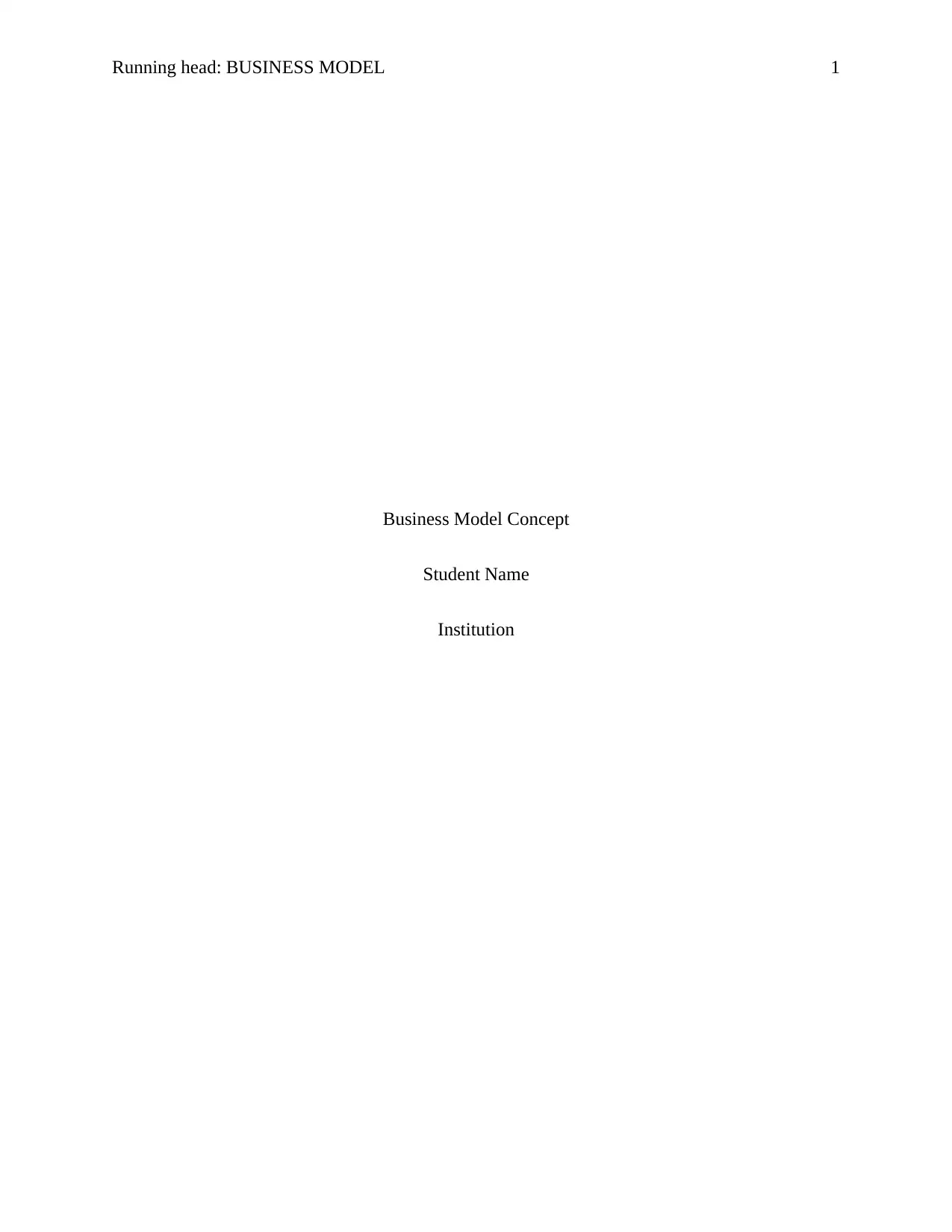
Running head: BUSINESS MODEL 1
Business Model Concept
Student Name
Institution
Business Model Concept
Student Name
Institution
Paraphrase This Document
Need a fresh take? Get an instant paraphrase of this document with our AI Paraphraser
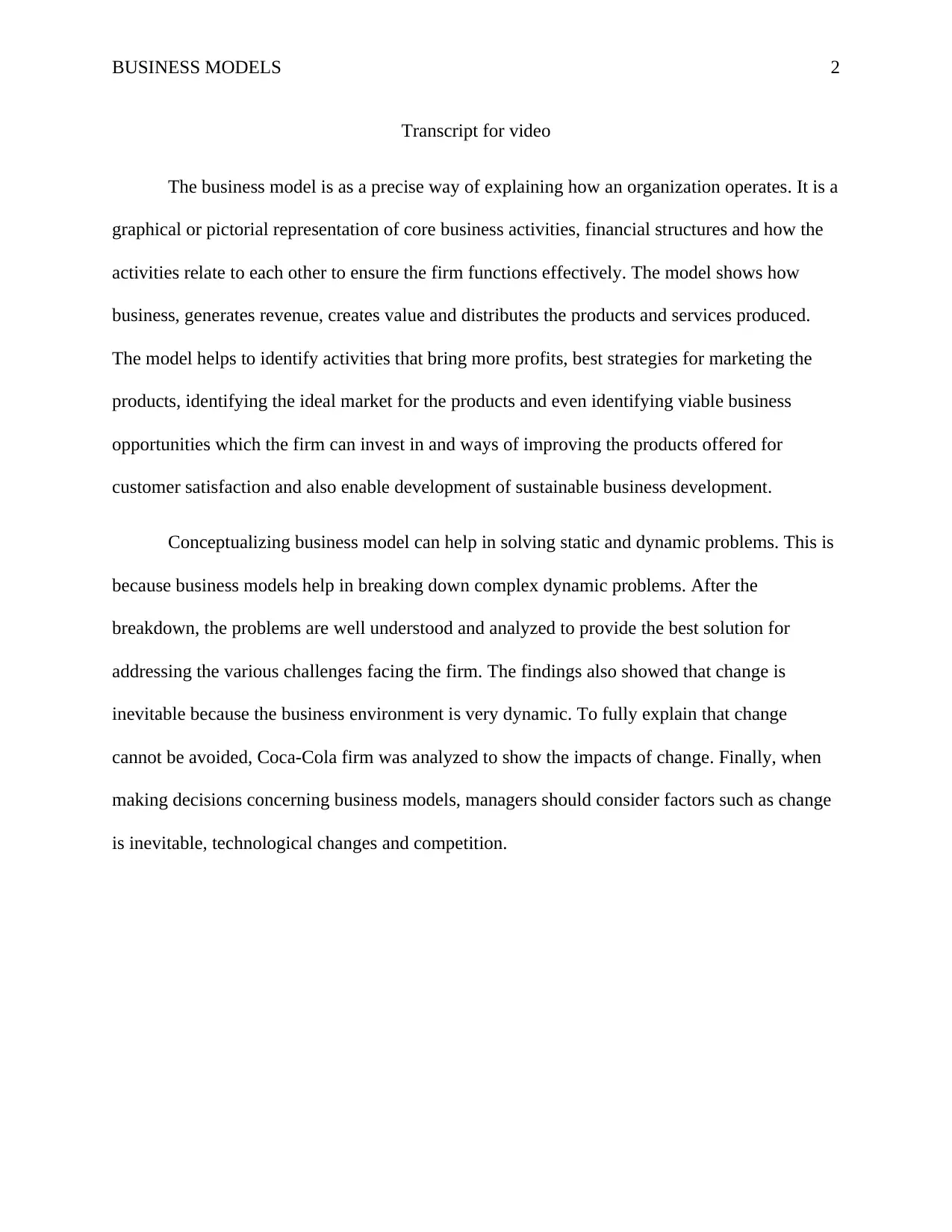
BUSINESS MODELS 2
Transcript for video
The business model is as a precise way of explaining how an organization operates. It is a
graphical or pictorial representation of core business activities, financial structures and how the
activities relate to each other to ensure the firm functions effectively. The model shows how
business, generates revenue, creates value and distributes the products and services produced.
The model helps to identify activities that bring more profits, best strategies for marketing the
products, identifying the ideal market for the products and even identifying viable business
opportunities which the firm can invest in and ways of improving the products offered for
customer satisfaction and also enable development of sustainable business development.
Conceptualizing business model can help in solving static and dynamic problems. This is
because business models help in breaking down complex dynamic problems. After the
breakdown, the problems are well understood and analyzed to provide the best solution for
addressing the various challenges facing the firm. The findings also showed that change is
inevitable because the business environment is very dynamic. To fully explain that change
cannot be avoided, Coca-Cola firm was analyzed to show the impacts of change. Finally, when
making decisions concerning business models, managers should consider factors such as change
is inevitable, technological changes and competition.
Transcript for video
The business model is as a precise way of explaining how an organization operates. It is a
graphical or pictorial representation of core business activities, financial structures and how the
activities relate to each other to ensure the firm functions effectively. The model shows how
business, generates revenue, creates value and distributes the products and services produced.
The model helps to identify activities that bring more profits, best strategies for marketing the
products, identifying the ideal market for the products and even identifying viable business
opportunities which the firm can invest in and ways of improving the products offered for
customer satisfaction and also enable development of sustainable business development.
Conceptualizing business model can help in solving static and dynamic problems. This is
because business models help in breaking down complex dynamic problems. After the
breakdown, the problems are well understood and analyzed to provide the best solution for
addressing the various challenges facing the firm. The findings also showed that change is
inevitable because the business environment is very dynamic. To fully explain that change
cannot be avoided, Coca-Cola firm was analyzed to show the impacts of change. Finally, when
making decisions concerning business models, managers should consider factors such as change
is inevitable, technological changes and competition.
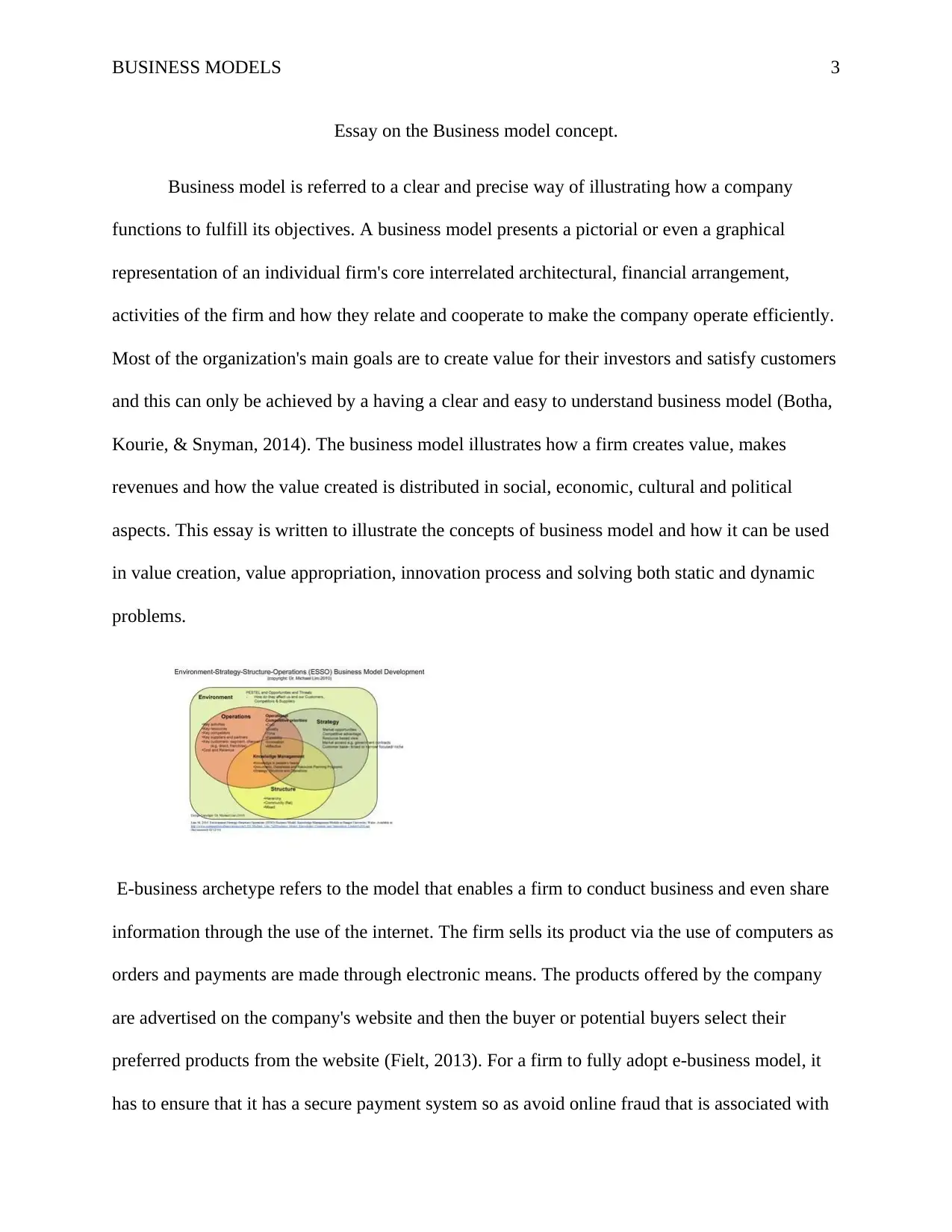
BUSINESS MODELS 3
Essay on the Business model concept.
Business model is referred to a clear and precise way of illustrating how a company
functions to fulfill its objectives. A business model presents a pictorial or even a graphical
representation of an individual firm's core interrelated architectural, financial arrangement,
activities of the firm and how they relate and cooperate to make the company operate efficiently.
Most of the organization's main goals are to create value for their investors and satisfy customers
and this can only be achieved by a having a clear and easy to understand business model (Botha,
Kourie, & Snyman, 2014). The business model illustrates how a firm creates value, makes
revenues and how the value created is distributed in social, economic, cultural and political
aspects. This essay is written to illustrate the concepts of business model and how it can be used
in value creation, value appropriation, innovation process and solving both static and dynamic
problems.
E-business archetype refers to the model that enables a firm to conduct business and even share
information through the use of the internet. The firm sells its product via the use of computers as
orders and payments are made through electronic means. The products offered by the company
are advertised on the company's website and then the buyer or potential buyers select their
preferred products from the website (Fielt, 2013). For a firm to fully adopt e-business model, it
has to ensure that it has a secure payment system so as avoid online fraud that is associated with
Essay on the Business model concept.
Business model is referred to a clear and precise way of illustrating how a company
functions to fulfill its objectives. A business model presents a pictorial or even a graphical
representation of an individual firm's core interrelated architectural, financial arrangement,
activities of the firm and how they relate and cooperate to make the company operate efficiently.
Most of the organization's main goals are to create value for their investors and satisfy customers
and this can only be achieved by a having a clear and easy to understand business model (Botha,
Kourie, & Snyman, 2014). The business model illustrates how a firm creates value, makes
revenues and how the value created is distributed in social, economic, cultural and political
aspects. This essay is written to illustrate the concepts of business model and how it can be used
in value creation, value appropriation, innovation process and solving both static and dynamic
problems.
E-business archetype refers to the model that enables a firm to conduct business and even share
information through the use of the internet. The firm sells its product via the use of computers as
orders and payments are made through electronic means. The products offered by the company
are advertised on the company's website and then the buyer or potential buyers select their
preferred products from the website (Fielt, 2013). For a firm to fully adopt e-business model, it
has to ensure that it has a secure payment system so as avoid online fraud that is associated with
⊘ This is a preview!⊘
Do you want full access?
Subscribe today to unlock all pages.

Trusted by 1+ million students worldwide
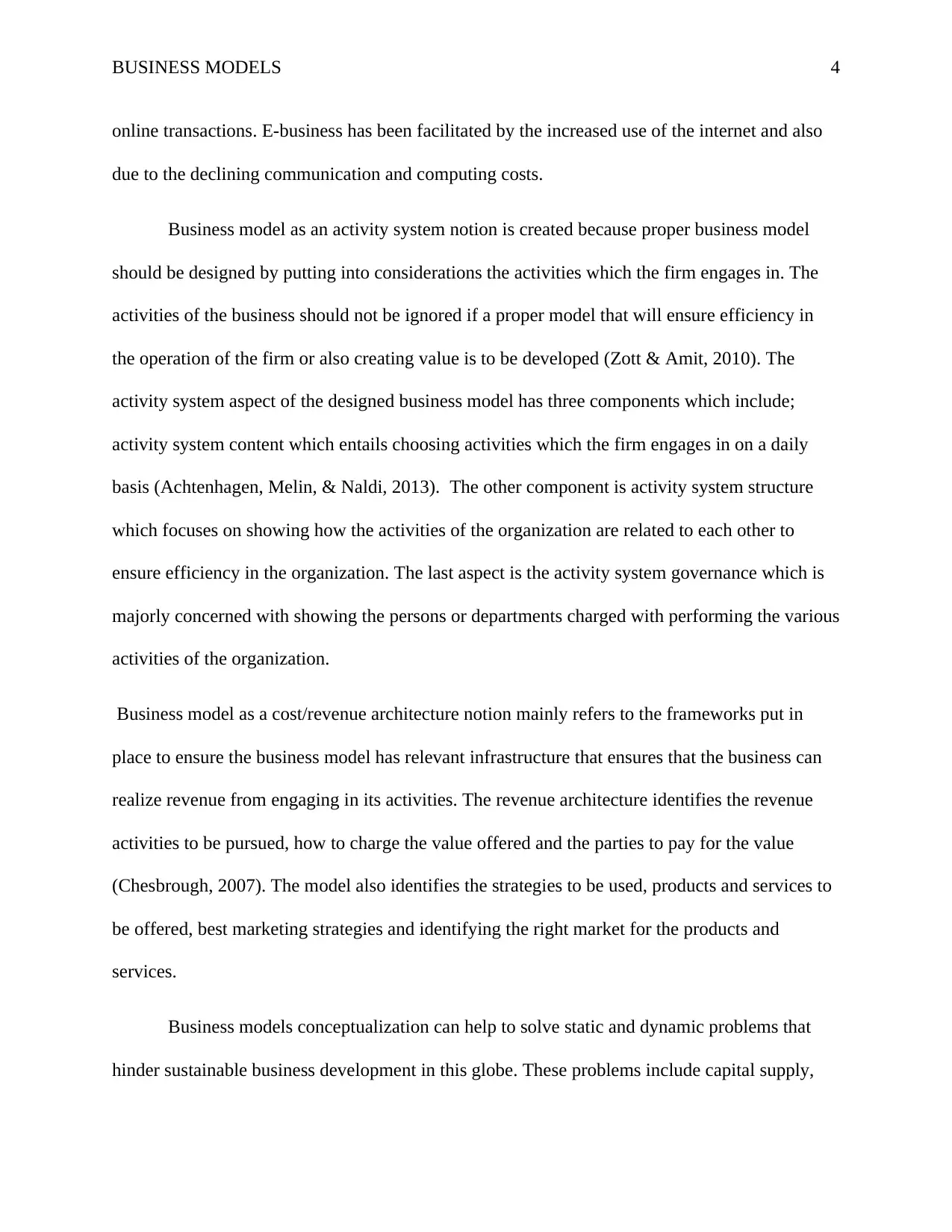
BUSINESS MODELS 4
online transactions. E-business has been facilitated by the increased use of the internet and also
due to the declining communication and computing costs.
Business model as an activity system notion is created because proper business model
should be designed by putting into considerations the activities which the firm engages in. The
activities of the business should not be ignored if a proper model that will ensure efficiency in
the operation of the firm or also creating value is to be developed (Zott & Amit, 2010). The
activity system aspect of the designed business model has three components which include;
activity system content which entails choosing activities which the firm engages in on a daily
basis (Achtenhagen, Melin, & Naldi, 2013). The other component is activity system structure
which focuses on showing how the activities of the organization are related to each other to
ensure efficiency in the organization. The last aspect is the activity system governance which is
majorly concerned with showing the persons or departments charged with performing the various
activities of the organization.
Business model as a cost/revenue architecture notion mainly refers to the frameworks put in
place to ensure the business model has relevant infrastructure that ensures that the business can
realize revenue from engaging in its activities. The revenue architecture identifies the revenue
activities to be pursued, how to charge the value offered and the parties to pay for the value
(Chesbrough, 2007). The model also identifies the strategies to be used, products and services to
be offered, best marketing strategies and identifying the right market for the products and
services.
Business models conceptualization can help to solve static and dynamic problems that
hinder sustainable business development in this globe. These problems include capital supply,
online transactions. E-business has been facilitated by the increased use of the internet and also
due to the declining communication and computing costs.
Business model as an activity system notion is created because proper business model
should be designed by putting into considerations the activities which the firm engages in. The
activities of the business should not be ignored if a proper model that will ensure efficiency in
the operation of the firm or also creating value is to be developed (Zott & Amit, 2010). The
activity system aspect of the designed business model has three components which include;
activity system content which entails choosing activities which the firm engages in on a daily
basis (Achtenhagen, Melin, & Naldi, 2013). The other component is activity system structure
which focuses on showing how the activities of the organization are related to each other to
ensure efficiency in the organization. The last aspect is the activity system governance which is
majorly concerned with showing the persons or departments charged with performing the various
activities of the organization.
Business model as a cost/revenue architecture notion mainly refers to the frameworks put in
place to ensure the business model has relevant infrastructure that ensures that the business can
realize revenue from engaging in its activities. The revenue architecture identifies the revenue
activities to be pursued, how to charge the value offered and the parties to pay for the value
(Chesbrough, 2007). The model also identifies the strategies to be used, products and services to
be offered, best marketing strategies and identifying the right market for the products and
services.
Business models conceptualization can help to solve static and dynamic problems that
hinder sustainable business development in this globe. These problems include capital supply,
Paraphrase This Document
Need a fresh take? Get an instant paraphrase of this document with our AI Paraphraser
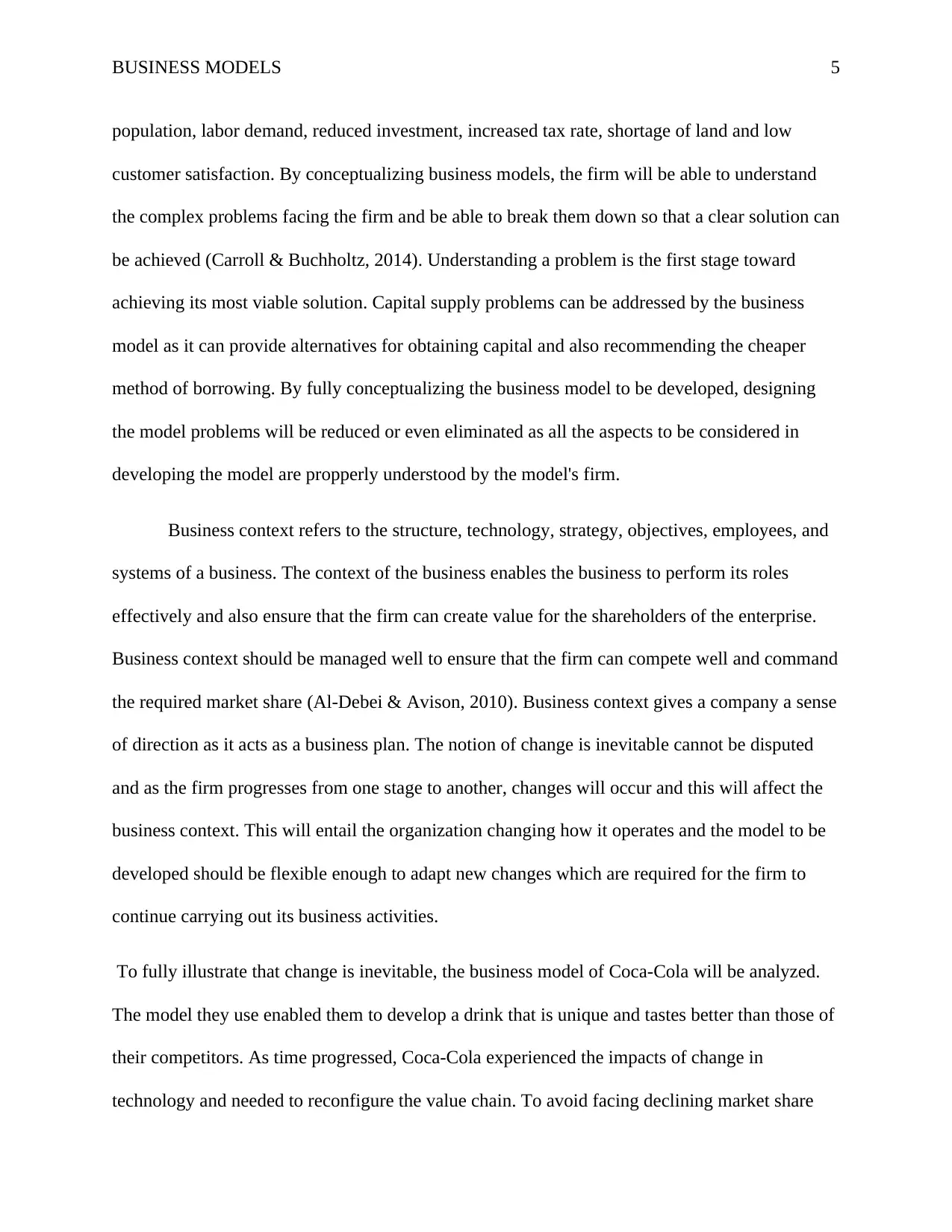
BUSINESS MODELS 5
population, labor demand, reduced investment, increased tax rate, shortage of land and low
customer satisfaction. By conceptualizing business models, the firm will be able to understand
the complex problems facing the firm and be able to break them down so that a clear solution can
be achieved (Carroll & Buchholtz, 2014). Understanding a problem is the first stage toward
achieving its most viable solution. Capital supply problems can be addressed by the business
model as it can provide alternatives for obtaining capital and also recommending the cheaper
method of borrowing. By fully conceptualizing the business model to be developed, designing
the model problems will be reduced or even eliminated as all the aspects to be considered in
developing the model are propperly understood by the model's firm.
Business context refers to the structure, technology, strategy, objectives, employees, and
systems of a business. The context of the business enables the business to perform its roles
effectively and also ensure that the firm can create value for the shareholders of the enterprise.
Business context should be managed well to ensure that the firm can compete well and command
the required market share (Al-Debei & Avison, 2010). Business context gives a company a sense
of direction as it acts as a business plan. The notion of change is inevitable cannot be disputed
and as the firm progresses from one stage to another, changes will occur and this will affect the
business context. This will entail the organization changing how it operates and the model to be
developed should be flexible enough to adapt new changes which are required for the firm to
continue carrying out its business activities.
To fully illustrate that change is inevitable, the business model of Coca-Cola will be analyzed.
The model they use enabled them to develop a drink that is unique and tastes better than those of
their competitors. As time progressed, Coca-Cola experienced the impacts of change in
technology and needed to reconfigure the value chain. To avoid facing declining market share
population, labor demand, reduced investment, increased tax rate, shortage of land and low
customer satisfaction. By conceptualizing business models, the firm will be able to understand
the complex problems facing the firm and be able to break them down so that a clear solution can
be achieved (Carroll & Buchholtz, 2014). Understanding a problem is the first stage toward
achieving its most viable solution. Capital supply problems can be addressed by the business
model as it can provide alternatives for obtaining capital and also recommending the cheaper
method of borrowing. By fully conceptualizing the business model to be developed, designing
the model problems will be reduced or even eliminated as all the aspects to be considered in
developing the model are propperly understood by the model's firm.
Business context refers to the structure, technology, strategy, objectives, employees, and
systems of a business. The context of the business enables the business to perform its roles
effectively and also ensure that the firm can create value for the shareholders of the enterprise.
Business context should be managed well to ensure that the firm can compete well and command
the required market share (Al-Debei & Avison, 2010). Business context gives a company a sense
of direction as it acts as a business plan. The notion of change is inevitable cannot be disputed
and as the firm progresses from one stage to another, changes will occur and this will affect the
business context. This will entail the organization changing how it operates and the model to be
developed should be flexible enough to adapt new changes which are required for the firm to
continue carrying out its business activities.
To fully illustrate that change is inevitable, the business model of Coca-Cola will be analyzed.
The model they use enabled them to develop a drink that is unique and tastes better than those of
their competitors. As time progressed, Coca-Cola experienced the impacts of change in
technology and needed to reconfigure the value chain. To avoid facing declining market share
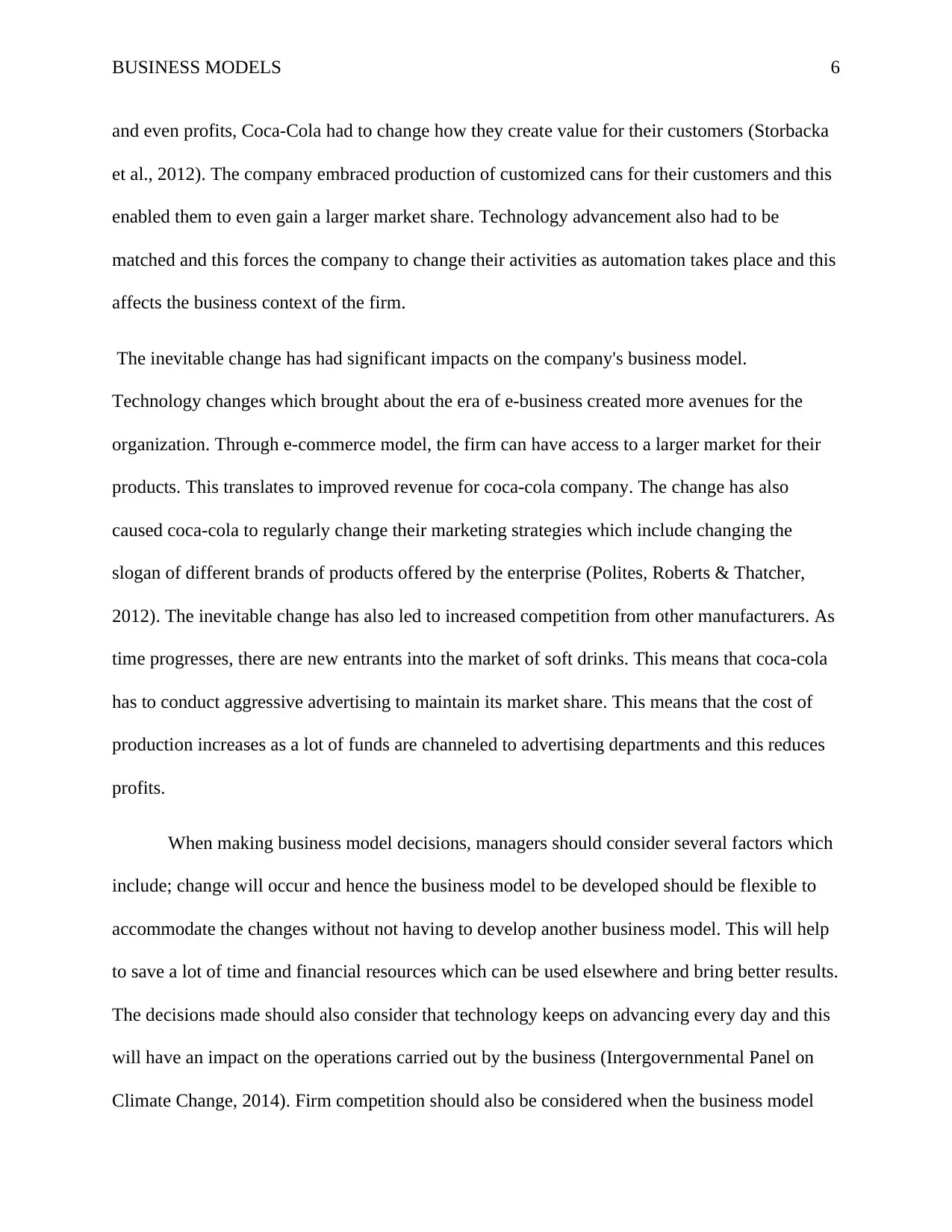
BUSINESS MODELS 6
and even profits, Coca-Cola had to change how they create value for their customers (Storbacka
et al., 2012). The company embraced production of customized cans for their customers and this
enabled them to even gain a larger market share. Technology advancement also had to be
matched and this forces the company to change their activities as automation takes place and this
affects the business context of the firm.
The inevitable change has had significant impacts on the company's business model.
Technology changes which brought about the era of e-business created more avenues for the
organization. Through e-commerce model, the firm can have access to a larger market for their
products. This translates to improved revenue for coca-cola company. The change has also
caused coca-cola to regularly change their marketing strategies which include changing the
slogan of different brands of products offered by the enterprise (Polites, Roberts & Thatcher,
2012). The inevitable change has also led to increased competition from other manufacturers. As
time progresses, there are new entrants into the market of soft drinks. This means that coca-cola
has to conduct aggressive advertising to maintain its market share. This means that the cost of
production increases as a lot of funds are channeled to advertising departments and this reduces
profits.
When making business model decisions, managers should consider several factors which
include; change will occur and hence the business model to be developed should be flexible to
accommodate the changes without not having to develop another business model. This will help
to save a lot of time and financial resources which can be used elsewhere and bring better results.
The decisions made should also consider that technology keeps on advancing every day and this
will have an impact on the operations carried out by the business (Intergovernmental Panel on
Climate Change, 2014). Firm competition should also be considered when the business model
and even profits, Coca-Cola had to change how they create value for their customers (Storbacka
et al., 2012). The company embraced production of customized cans for their customers and this
enabled them to even gain a larger market share. Technology advancement also had to be
matched and this forces the company to change their activities as automation takes place and this
affects the business context of the firm.
The inevitable change has had significant impacts on the company's business model.
Technology changes which brought about the era of e-business created more avenues for the
organization. Through e-commerce model, the firm can have access to a larger market for their
products. This translates to improved revenue for coca-cola company. The change has also
caused coca-cola to regularly change their marketing strategies which include changing the
slogan of different brands of products offered by the enterprise (Polites, Roberts & Thatcher,
2012). The inevitable change has also led to increased competition from other manufacturers. As
time progresses, there are new entrants into the market of soft drinks. This means that coca-cola
has to conduct aggressive advertising to maintain its market share. This means that the cost of
production increases as a lot of funds are channeled to advertising departments and this reduces
profits.
When making business model decisions, managers should consider several factors which
include; change will occur and hence the business model to be developed should be flexible to
accommodate the changes without not having to develop another business model. This will help
to save a lot of time and financial resources which can be used elsewhere and bring better results.
The decisions made should also consider that technology keeps on advancing every day and this
will have an impact on the operations carried out by the business (Intergovernmental Panel on
Climate Change, 2014). Firm competition should also be considered when the business model
⊘ This is a preview!⊘
Do you want full access?
Subscribe today to unlock all pages.

Trusted by 1+ million students worldwide
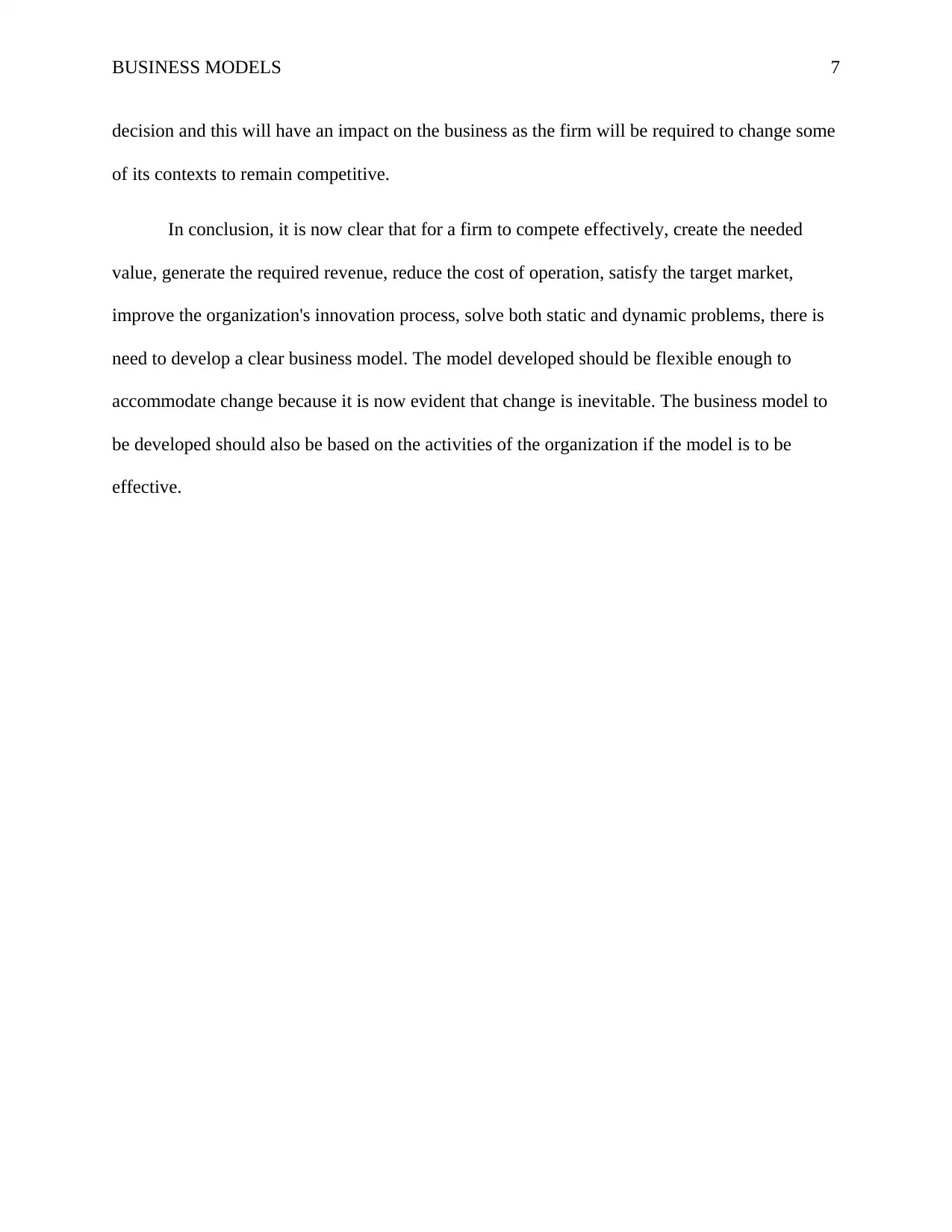
BUSINESS MODELS 7
decision and this will have an impact on the business as the firm will be required to change some
of its contexts to remain competitive.
In conclusion, it is now clear that for a firm to compete effectively, create the needed
value, generate the required revenue, reduce the cost of operation, satisfy the target market,
improve the organization's innovation process, solve both static and dynamic problems, there is
need to develop a clear business model. The model developed should be flexible enough to
accommodate change because it is now evident that change is inevitable. The business model to
be developed should also be based on the activities of the organization if the model is to be
effective.
decision and this will have an impact on the business as the firm will be required to change some
of its contexts to remain competitive.
In conclusion, it is now clear that for a firm to compete effectively, create the needed
value, generate the required revenue, reduce the cost of operation, satisfy the target market,
improve the organization's innovation process, solve both static and dynamic problems, there is
need to develop a clear business model. The model developed should be flexible enough to
accommodate change because it is now evident that change is inevitable. The business model to
be developed should also be based on the activities of the organization if the model is to be
effective.
Paraphrase This Document
Need a fresh take? Get an instant paraphrase of this document with our AI Paraphraser
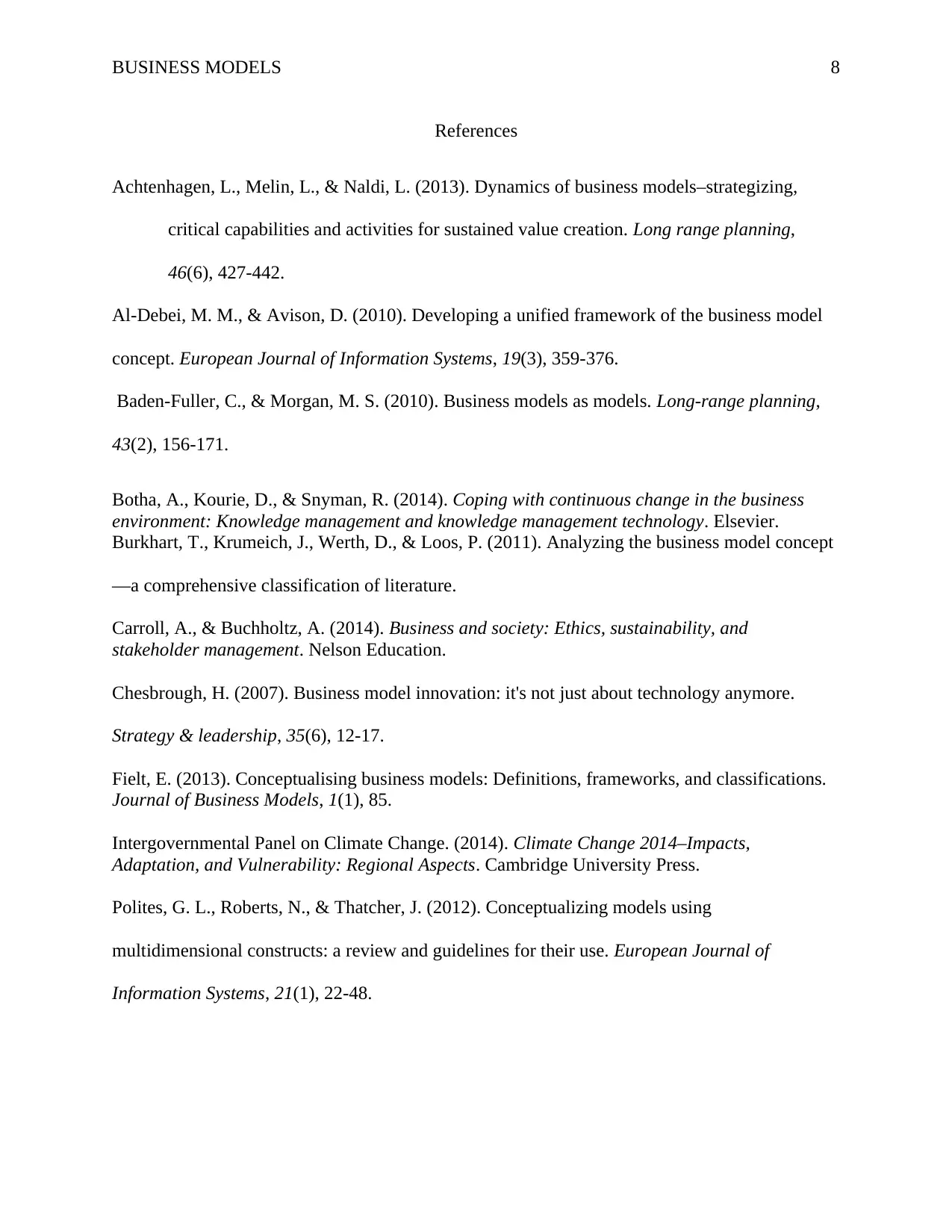
BUSINESS MODELS 8
References
Achtenhagen, L., Melin, L., & Naldi, L. (2013). Dynamics of business models–strategizing,
critical capabilities and activities for sustained value creation. Long range planning,
46(6), 427-442.
Al-Debei, M. M., & Avison, D. (2010). Developing a unified framework of the business model
concept. European Journal of Information Systems, 19(3), 359-376.
Baden-Fuller, C., & Morgan, M. S. (2010). Business models as models. Long-range planning,
43(2), 156-171.
Botha, A., Kourie, D., & Snyman, R. (2014). Coping with continuous change in the business
environment: Knowledge management and knowledge management technology. Elsevier.
Burkhart, T., Krumeich, J., Werth, D., & Loos, P. (2011). Analyzing the business model concept
—a comprehensive classification of literature.
Carroll, A., & Buchholtz, A. (2014). Business and society: Ethics, sustainability, and
stakeholder management. Nelson Education.
Chesbrough, H. (2007). Business model innovation: it's not just about technology anymore.
Strategy & leadership, 35(6), 12-17.
Fielt, E. (2013). Conceptualising business models: Definitions, frameworks, and classifications.
Journal of Business Models, 1(1), 85.
Intergovernmental Panel on Climate Change. (2014). Climate Change 2014–Impacts,
Adaptation, and Vulnerability: Regional Aspects. Cambridge University Press.
Polites, G. L., Roberts, N., & Thatcher, J. (2012). Conceptualizing models using
multidimensional constructs: a review and guidelines for their use. European Journal of
Information Systems, 21(1), 22-48.
References
Achtenhagen, L., Melin, L., & Naldi, L. (2013). Dynamics of business models–strategizing,
critical capabilities and activities for sustained value creation. Long range planning,
46(6), 427-442.
Al-Debei, M. M., & Avison, D. (2010). Developing a unified framework of the business model
concept. European Journal of Information Systems, 19(3), 359-376.
Baden-Fuller, C., & Morgan, M. S. (2010). Business models as models. Long-range planning,
43(2), 156-171.
Botha, A., Kourie, D., & Snyman, R. (2014). Coping with continuous change in the business
environment: Knowledge management and knowledge management technology. Elsevier.
Burkhart, T., Krumeich, J., Werth, D., & Loos, P. (2011). Analyzing the business model concept
—a comprehensive classification of literature.
Carroll, A., & Buchholtz, A. (2014). Business and society: Ethics, sustainability, and
stakeholder management. Nelson Education.
Chesbrough, H. (2007). Business model innovation: it's not just about technology anymore.
Strategy & leadership, 35(6), 12-17.
Fielt, E. (2013). Conceptualising business models: Definitions, frameworks, and classifications.
Journal of Business Models, 1(1), 85.
Intergovernmental Panel on Climate Change. (2014). Climate Change 2014–Impacts,
Adaptation, and Vulnerability: Regional Aspects. Cambridge University Press.
Polites, G. L., Roberts, N., & Thatcher, J. (2012). Conceptualizing models using
multidimensional constructs: a review and guidelines for their use. European Journal of
Information Systems, 21(1), 22-48.
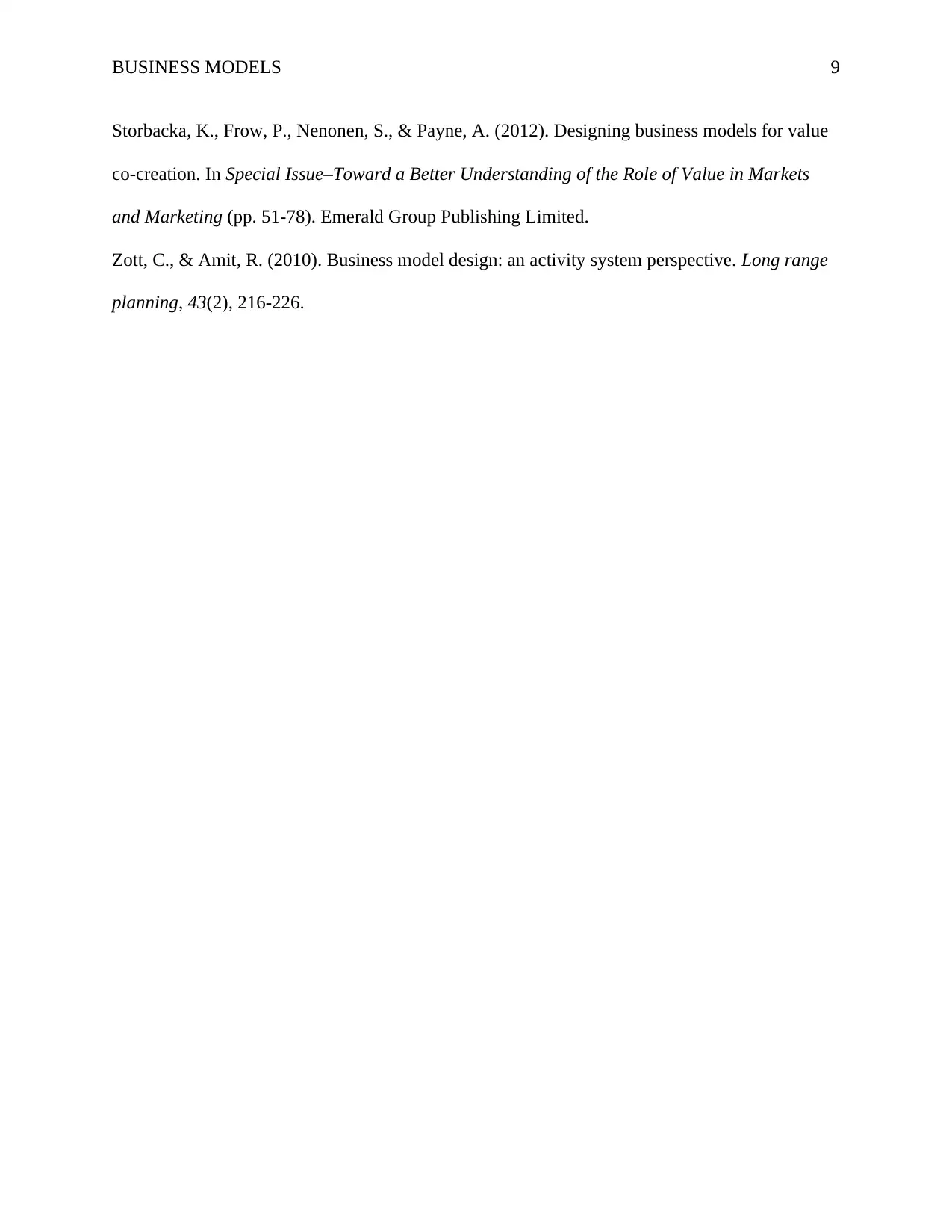
BUSINESS MODELS 9
Storbacka, K., Frow, P., Nenonen, S., & Payne, A. (2012). Designing business models for value
co-creation. In Special Issue–Toward a Better Understanding of the Role of Value in Markets
and Marketing (pp. 51-78). Emerald Group Publishing Limited.
Zott, C., & Amit, R. (2010). Business model design: an activity system perspective. Long range
planning, 43(2), 216-226.
Storbacka, K., Frow, P., Nenonen, S., & Payne, A. (2012). Designing business models for value
co-creation. In Special Issue–Toward a Better Understanding of the Role of Value in Markets
and Marketing (pp. 51-78). Emerald Group Publishing Limited.
Zott, C., & Amit, R. (2010). Business model design: an activity system perspective. Long range
planning, 43(2), 216-226.
⊘ This is a preview!⊘
Do you want full access?
Subscribe today to unlock all pages.

Trusted by 1+ million students worldwide
1 out of 9
Related Documents
Your All-in-One AI-Powered Toolkit for Academic Success.
+13062052269
info@desklib.com
Available 24*7 on WhatsApp / Email
![[object Object]](/_next/static/media/star-bottom.7253800d.svg)
Unlock your academic potential
Copyright © 2020–2025 A2Z Services. All Rights Reserved. Developed and managed by ZUCOL.





